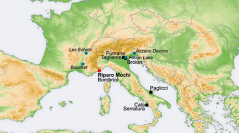

 Comptes Rendus Palevol
18 (1) - Pages 13-23
Comptes Rendus Palevol
18 (1) - Pages 13-23Riparo Mochi is considered a key site for the Middle–Upper Palaeolithic chrono-cultural sequence in the Mediterranean area. Climatic and environmental conditions have been reconstructed after the study of the small mammal assemblage by means of linear regression method and the Habitat Weighting method. The climate proxies for the late Mousterian and Proto-Aurignacian (cultural units I to G) indicate an environment with a relative high percentage of forest component during two cold and one relative warm oscillations. Open environments with low temperatures are registered for the Gravettian (cultural Unit D) allowing a possible relation to the Heinrich 3 Event. The final Gravettian (cultural Unit C) shows a relative warm peak, tentatively related to Greenland Interstadial 2. The late Epigravettian (cultural Unit A) is characterized by a high percentage of forest-related environment suggesting that this horizon formed during the Bølling–Allerød Interstadial. Finally, the Riparo Mochi sequence contributes to reconstruct the processes of faunal changes along the northern Tyrrhenian coast in a period of climatic instability, especially during the end of Marine Isotope Stage 3 when foraging groups adopted different mobility strategies between southern France and the Italian peninsula.
Upper Pleistocene, Paleoclimatology, Late Glacial, Gravettian, Insectivores, Rodents